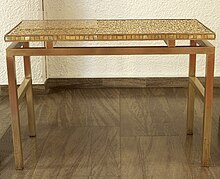Sideboard
In the Catholic liturgy , the sideboard (also known as a gift table or sideboard ) is a table often covered with a white linen cloth , which is used to hold the liturgical utensils that are used in the liturgy and especially for the celebration of the Eucharist . These are usually the chalice with paten , corporals , chalice cloth , Palla and chalice veil , the cruet for sacramental wine and water Lavabotablett with the Lavabotuch. The purification of the liturgical vessels can also take place at the sideboard.
The lectionary and other liturgical books are also often placed on the sideboard before and after readings and prayers. The sideboard is prepared before the service and looked after by the acolytes during the mass .
In the Italian Renaissance , the sideboard was initially one next to the dining table standing sideboard . In Austria (but also the Czech Republic , Slovenia , Croatia etc.) a sideboard is a piece of furniture with a shelf and a box that is also used as a sideboard.
etymology
The word is derived from the Latin credere "believe, trust" or Italian credenza "Faith, trust". In times when kings still needed taster to prevent poison attacks, the dishes were certified by taster and found to be harmless. The proffered shares could therefore be consumed carefree.
As part of her trousseau, Elizabeth of Aragón brought a sideboard with her, a vessel studded with shark teeth, through which one could allegedly recognize poisoned food.
See also
Individual evidence
- ↑ Sigrid-Maria Großering : To crown and love , Amalthea Verlag
Web links
- Pastoral Introductions - Different Forms of Celebration of Mass - Celebration of Mass with the Congregation - Preparation - 80.c

